
The Red Data Book of the Kaliningrad region
The project is done by Litvinko Polina
Fedotova Kseniya
Panushkina Victoria
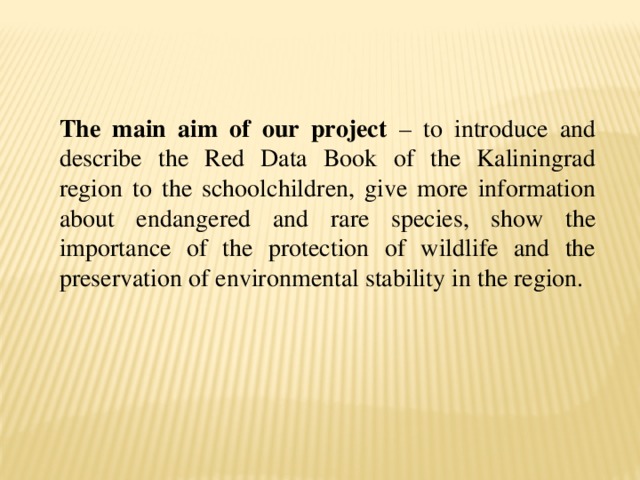
The main aim of our project – to introduce and describe the Red Data Book of the Kaliningrad region to the schoolchildren, give more information about endangered and rare species, show the importance of the protection of wildlife and the preservation of environmental stability in the region.

The Red Data Book of the Kaliningrad region contains information about local rare and endangered forms of animal and vegetable life. It was prepared in accordance with the regional Law on the Red Data Book of the Kaliningrad Region adopted by the fourth Kaliningrad regional Duma on April 22, 2010. Under article 1, paragraph 2 of the Law, the Red Data Book of the Kaliningrad region is established in order to protect biological diversity, maintain and restore the numbers of rare and endangered species (subspecies, populations) of animals, plants, fungi, and lichens, maintain and restore their habitats in the Kaliningrad region, and to spread environmental awareness and culture.
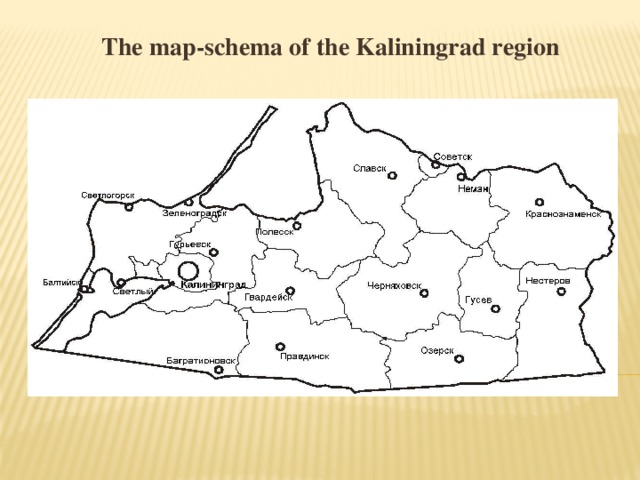
The map-schema of the Kaliningrad region

There are 5 categories of the taxa (species, subspecies)
0 – apparently deleted species
1 – endangered species
2 – population decline
3 – rare species
4 – status indeterminate
Legends on the maps of the texts
– places of local spreading
– places of last spreading
– spreading territory of species
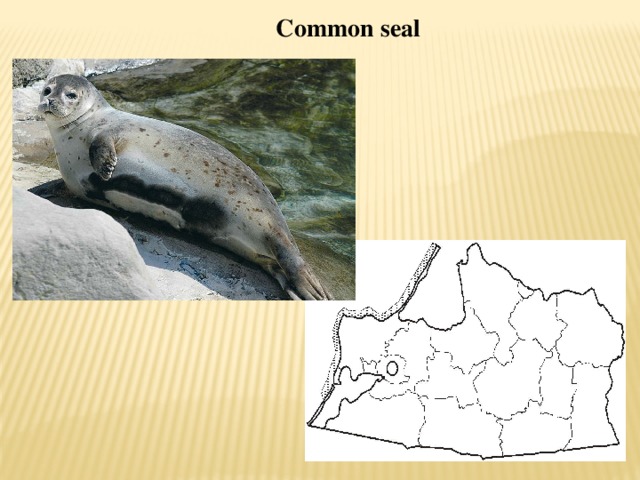
Common seal
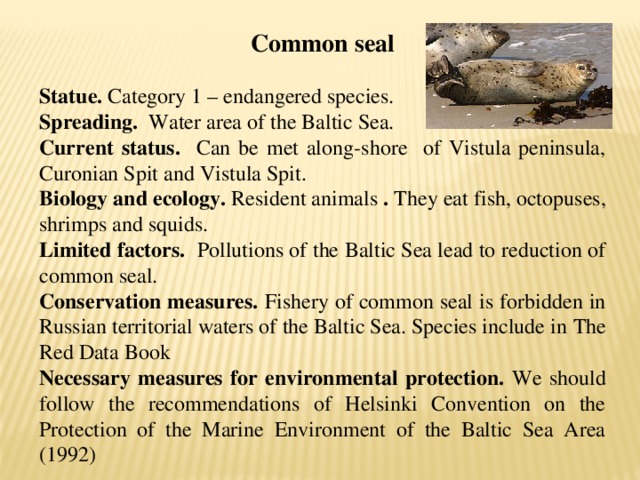
Common seal
Statue. Category 1 – endangered species.
Spreading. Water area of the Baltic Sea.
Current status. Can be met along-shore of Vistula peninsula, Curonian Spit and Vistula Spit.
Biology and ecology. Resident animals . They eat fish, octopuses, shrimps and squids.
Limited factors. Pollutions of the Baltic Sea lead to reduction of common seal.
Conservation measures. Fishery of common seal is forbidden in Russian territorial waters of the Baltic Sea. Species include in The Red Data Book
Necessary measures for environmental protection. We should follow the recommendations of Helsinki Convention on the Protection of the Marine Environment of the Baltic Sea Area (1992)

The Red Data Book of the Kaliningrad Region covers
- 11 mammal species
- 43 bird species
- 1 reptile species
- 1 amphibia species
- 4 fish and cyclostome species
- 23 insect species
- 6 mollusc species
- 83 vascular plant species
- 4 moss species
- 9 lichen species
- 19 fungi species.
Felix lynx
Sphagnum denticulatum

The leading specialists of the Departments of Botanic and Plant Ecology, Ecology and Zoology of the Immanuel Kant University of Russian and the Departments of Ichthyology and Ecology, Ichthyopathology and Hydrobiology of Kaliningrad State Technical University contributed to the Book the data sheets on rare species and species that require protection, which were compiled under the supervision of Prof. Viktor Dedkov.
Prof. Viktor Dedkov
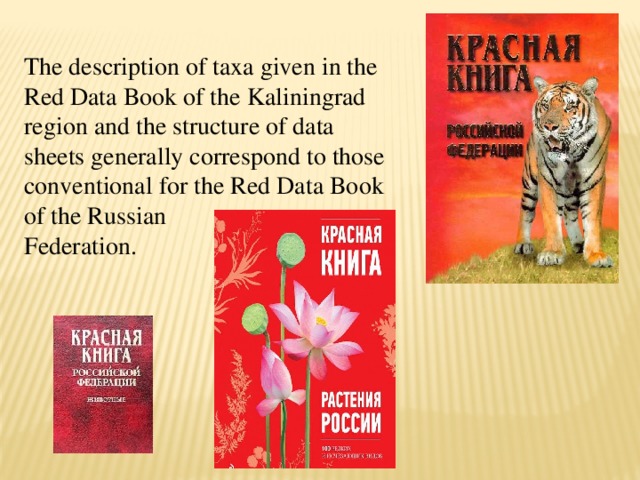
The description of taxa given in the Red Data Book of the Kaliningrad region and the structure of data sheets generally correspond to those conventional for the Red Data Book of the Russian Federation.
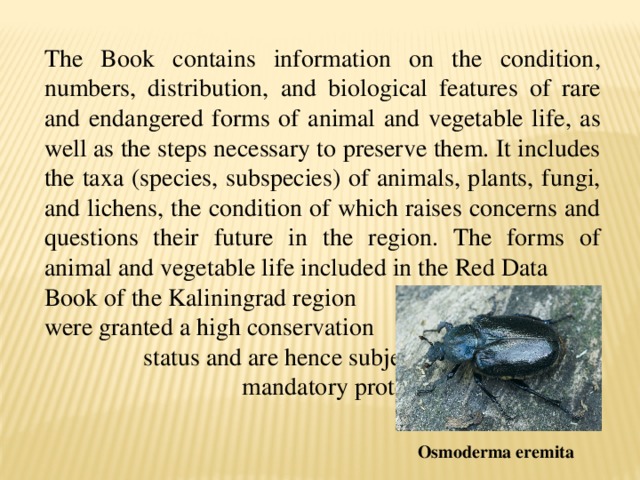
The Book contains information on the condition, numbers, distribution, and biological features of rare and endangered forms of animal and vegetable life, as well as the steps necessary to preserve them. It includes the taxa (species, subspecies) of animals, plants, fungi, and lichens, the condition of which raises concerns and questions their future in the region. The forms of animal and vegetable life included in the Red Data
Book of the Kaliningrad region were granted a high conservation status and are hence subjects of mandatory protection.
Osmoderma eremita
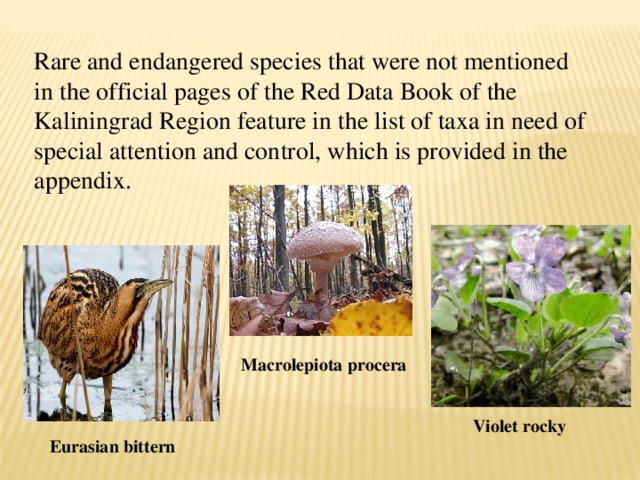
Rare and endangered species that were not mentioned in the official pages of the Red Data Book of the Kaliningrad Region feature in the list of taxa in need of special attention and control, which is provided in the appendix.
Macrolepiota procera
Violet rocky
Eurasian bittern
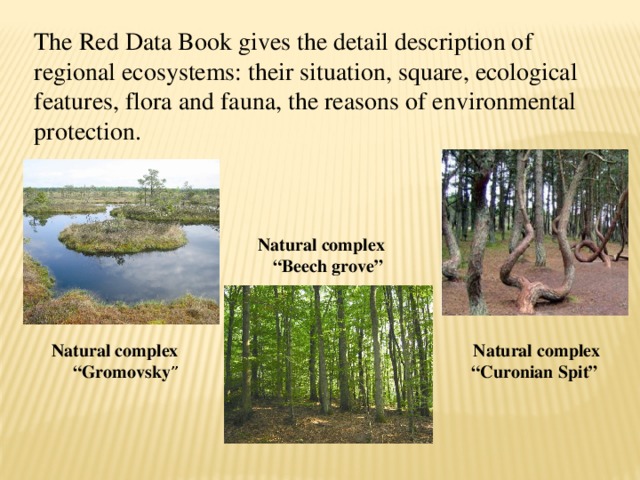
The Red Data Book gives the detail description of regional ecosystems: their situation, square, ecological features, flora and fauna, the reasons of environmental protection.
Natural complex “Beech grove”
Natural complex “Gromovsky ”
Natural complex “Curonian Spit”

SAVE OUR NATURE FOR FUTURE GENERATION!
THANK YOU FOR YOUR ATTENTION!
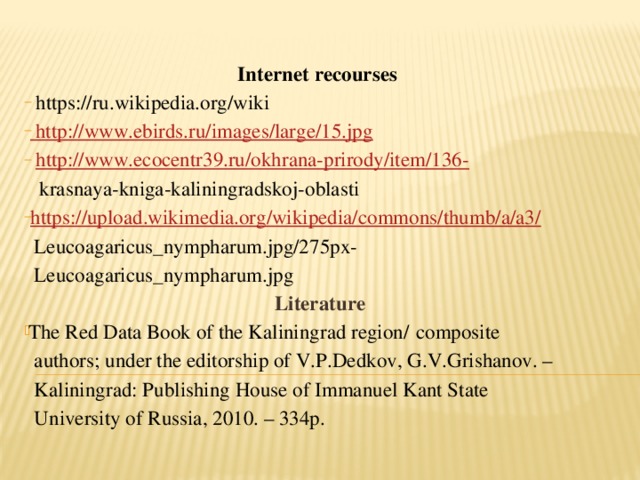
Internet recourses
- https://ru.wikipedia.org/wiki
- http://www.ebirds.ru/images/large/15.jpg
- http://www.ecocentr39.ru/okhrana-prirody/item/136-
krasnaya-kniga-kaliningradskoj-oblasti
- https://upload.wikimedia.org/wikipedia/commons/thumb/a/a3/
Leucoagaricus_nympharum.jpg/275px-
Leucoagaricus_nympharum.jpg
Literature
- The Red Data Book of the Kaliningrad region/ composite
authors; under the editorship of V.P.Dedkov, G.V.Grishanov. –
Kaliningrad: Publishing House of Immanuel Kant State
University of Russia, 2010. – 334p.






























